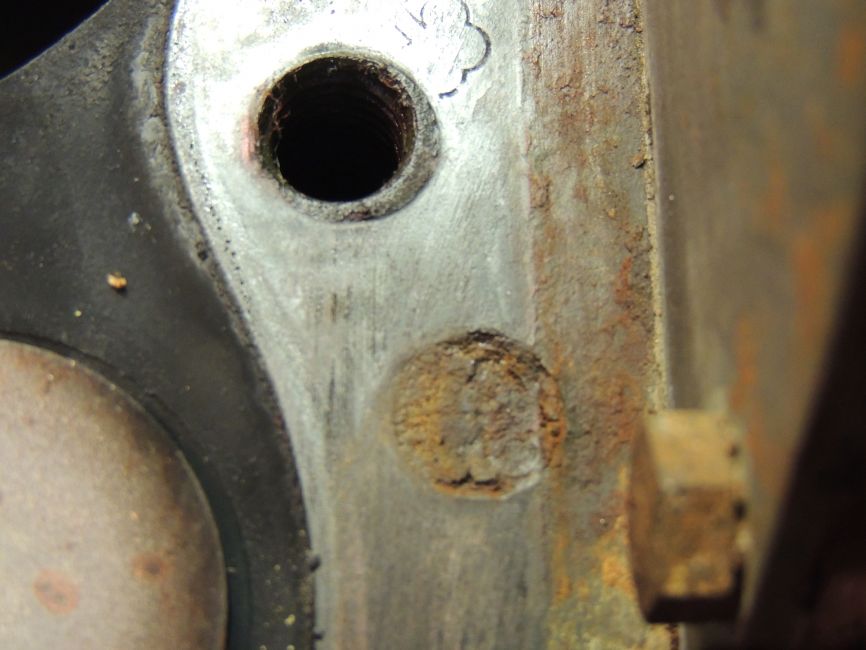
Posted by Clint Dixon [172.68.58.86] on Saturday, May 05, 2018 at 18:14:30 :

Question for you guys. This one has me stumped.
I tear apart my early 1951 B3PW this morning to check/replace the head gasket, clean out the carbon, and hopefully correct a run-hot condition that I have been experiencing the past couple of summers when the temps are in the high 80's and up.
This is a very early '51 with all of the old details that are exactly like the earlier trucks before they started making a lot of changes shortly into the B3PW model run (early dash, early rear fenders, early spare tire carrier, etc.).
The engine is original to the truck and the T137 engine number fits right into the truck serial number range that one would expect. I bought the truck from the original owner who ordered it new. From day one the truck was titled to the engine number rather than the trucks serial number. Proof that the engine has never been replaced. It has been rebuilt at least once in its lifetime. The original owner shared that information with me way back in the early 1980's. When I pulled the head today, I see the tops of the pistons are stamped .030.
The engine also wears the early head without the front hump needed to cover the extra coolant bypass cavity in the block. The water pump is also the early version with the coolant bypass exiting externally through a bolt-on flange on the top surface of the pump body, and the short hose connecting it to the nipple on the front of the thermostat housing.
So far, everything I would expect to see on an a very early 1951 B3PW from before the engine, head, head gasket, water pump, and thermostat housing all changed to allow internal coolant bypass.
I really thought I would find a leak through the head gasket allowing coolant into one of the cylinders. When I first start the truck, I smell coolant for a few minutes until everything gets good and warmed up. This started about 15 years ago after having a new core made for the radiator. For the first 10 years or so, I attributed it to a pinhole leak somewhere in the radiator that I cannot see. Since the truck has started running hotter on very hot summer days, I have been questioning the presence of coolant smell and am now at the point of head gasket replacement, thinking that some is leaking into a cylinder.
Anyway, I shared a long story to get to this point. Thanks, for bearing with me.
What I find today is no obvious leak at the gasket. But when I lifted away the head and gasket, what I saw really surprised me. See the attached image. At the front of the block, right behind the head of the bolt at the back of the waterpump, I see a water bypass hole in the top of the block that is completely packed full of who knows what, but it looks like all rust at the top. As you can see, the gasket (as well as head) did not have the hump and extra bypass hole, and neither was completely covering the hole in the block.
I have no way of knowing if the old style head, waterpump, and thermostat are original to the truck or not, now that I see this. It is obvious that this has been an assembly for a long time. I have been driving the truck since 2000 when I bought the truck from the widow. Her husband passed in 1994 and she continued to drive the truck for 6 years. Any previous rebuild had to have taken place prior to '94.
On the other hand, I get a very strong sense of deja vu when I look at this. I think I have seen it before but I do not recall ever having the head off of this truck. If I had, I would have installed a new gasket. As far as I know, all gaskets on the market since 2000 have had the extra hump and hole, except those from VPW etc. I always buy my gaskets locally. All of the gaskets I have removed over the years I have kept and they have the extra hump and hole. I of the spare head I have are the early type without hump. So, I did not change out the head at one time and forget. I would still have the old head today.
This one has me stumped. I do not want to go digging in the hole. It is completely dry and I do not want to open a hole that I have no way of covering to keep coolant from escaping.
Is this something that Dodge did to a few engine blocks in order to use up old heads? Could the previous owner switched to an older head, thermostat housing, and waterpump and figured out a way to plug that hole that actually worked for at least the past 20 years? Should I just put it back together with a new gasket?
Thanks,
Junior
Follow Ups: